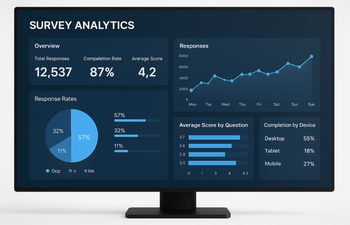Survey Analytics 101: Making Sense of Your Responses
Survey Analytics 101: Making Sense of Your Responses to uncover trends, identify insights, and turn feedback into actionable decisions.

Introduction
Data is the heartbeat of informed decision-making, and surveys offer one of the most direct channels to collect it. Yet, raw survey responses, whether open-ended or multiple-choice, rarely tell their story at a glance. They require context, interpretation, and, most critically, analytics. Survey Analytics 101: Making Sense of Your Responses explores how to extract meaning from this treasure trove of feedback, helping you transform noise into knowledge and patterns into plans.
What Is Survey Analytics?
Survey analytics is the systematic process of analyzing the responses gathered from a survey to derive insights. It involves collecting, cleaning, organizing, and interpreting data. Whether you’re surveying customers, employees, or general audiences, analytics helps reveal hidden trends and priorities.
The Role of Survey Analytics in Decision-Making
Survey data, when properly analyzed, acts as a compass guiding business strategies. Want to know why customer satisfaction dipped last quarter? Or which new feature users are craving? Survey analytics brings those answers to light, eliminating guesswork.
Preparing Your Data for Analysis
Before jumping into charts and graphs, preparation is key. It starts with data cleaning, removing incomplete or contradictory responses. Then, categorize and format the data so it aligns with the type of analysis you intend to perform.
- Remove duplicates and inconsistent entries
- Normalize scale-based responses (e.g., convert Likert scales to numerical values)
- Ensure anonymity where necessary to protect respondent privacy
Quantitative vs. Qualitative Responses
Surveys often collect both quantitative (numerical) and qualitative (textual) data. Quantitative data is easier to chart and model, while qualitative feedback gives depth and context.
If you're unsure whether to keep your survey short or go in-depth, our guide Short vs. Long Online Surveys: Which One Gets Better Data? explores how survey length impacts data quality and response rates.
Analyzing Multiple Choice Responses
Multiple choice questions are gold mines for statistical analysis. They reveal preferences, demographics, and behavioral patterns at a glance. Use frequency analysis to understand what the majority thinks, and cross-tabulation to uncover relationships between variables.
Visualizing Likert Scale Data
Likert scales (e.g., Strongly Agree to Strongly Disagree) offer nuanced opinions. These responses are ordinal and can be visualized using stacked bar charts or heatmaps. They offer insight into not just what respondents think, but how strongly they feel about it.
Cross-Tabulation: Finding Hidden Correlations
Cross-tabulation helps identify how different variables relate. For example, does customer satisfaction vary by location or product line? These insights often inform segmentation strategies or targeted improvements.
Open-Ended Responses: A Goldmine of Insight
While more difficult to analyze, open-ended responses offer detailed opinions. Use keyword extraction, sentiment analysis, or manual thematic coding to pull trends from narrative data. Word clouds can also visualize commonly mentioned themes.
Coding Qualitative Responses
This involves categorizing open-ended answers into themes. Start with a sample of responses, identify recurring topics, and apply these categories across the dataset.
- Identify major recurring keywords
- Create a codebook for categorization
- Apply tags consistently
Using Sentiment Analysis
Sentiment analysis identifies whether a response is positive, negative, or neutral. Tools like MonkeyLearn or built-in features in survey platforms can automate this process and present the overall emotional tone of your respondents.
Weighted Averages for Score-Based Questions
Not all responses should carry the same weight. If your survey gives more significance to certain groups (e.g., long-term customers), then using weighted averages offers a more accurate reflection.
Time-Series Analysis in Surveys
If you’re conducting repeated surveys over time, time-series analysis helps track changes in sentiment, satisfaction, or behavior. Visual tools like line graphs are useful here.
Using Dashboards for Real-Time Insights
Dashboards provide a snapshot of your survey performance in real-time. Tools like Tableau, Power BI, or Google Data Studio integrate with survey platforms for live tracking.
Filtering Responses Based on Demographics
To get more granular, filter survey responses by age, gender, location, or user segment. This dissection often reveals patterns otherwise hidden in aggregated data.
Reporting Your Findings Effectively
After analysis comes communication. Use visuals, bullet points, and concise language. Ensure that your findings are actionable, recommend next steps, not just insights.
Common Mistakes in Survey Analytics
Watch out for these common pitfalls:
The way you phrase and structure your questions can make or break your analysis. For a list of pitfalls to avoid, see Survey Question Mistakes That Are Ruining Your Response Rate.
- Overgeneralizing from small samples
- Misinterpreting Likert scales as interval data
- Ignoring margin of error in percentage-based conclusions
Ethics in Survey Data Handling
Be transparent about how data is used. Always anonymize sensitive data and obtain informed consent. Ethical analysis builds trust and ensures long-term participation.
Choosing the Right Tool for Survey Analytics
Your choice of tool depends on complexity and volume:
Automating Survey Analytics
Automation tools can schedule recurring analyses, generate reports, and alert you to significant changes in data patterns. This streamlines operations and ensures timely insights.
Benchmarking Against Industry Standards
Compare your metrics with industry benchmarks. This contextualizes your results and helps set realistic goals. Survey platforms like SurveyMonkey often publish benchmark data.
Segmenting Your Audience
Segmentation lets you tailor actions based on who said what. By grouping responses from different audience profiles, you gain precision in strategy and messaging.
From Data to Decisions
Insights are only valuable if acted upon. Develop action plans based on your findings. Align them with business goals and regularly revisit the data to track progress.
Survey Analytics 101
Understanding how to navigate the sea of survey responses is a must-have skill in today’s data-driven world. Whether it’s customer satisfaction, employee engagement, or market research, the ability to translate survey data into strategy is transformative. Survey analytics empowers organizations to listen, learn, and lead more effectively.
Final Thoughts
Survey analytics is more than number crunching, it's about listening with intent and responding with purpose. With the right tools and mindset, even the most complex dataset can become a clear roadmap for improvement. Remember, every response is a voice. Make sure it's heard and understood.
Frequently Asked Questions
Find answers to the most common questions about this topic
Survey analytics is the process of examining, interpreting, and drawing conclusions from the data collected through surveys.
It helps in understanding customer preferences, improving products or services, and making data-driven business decisions.
They include cleaning data, categorizing responses, visualizing trends, and interpreting insights.
Yes, through qualitative coding, sentiment analysis, or natural language processing techniques.
Tools like Excel, Google Sheets, Tableau, Power BI, and specialized platforms like Qualtrics and SurveyMonkey are commonly used.
Using bar charts, pie charts, word clouds, and cross-tabulation tables helps make the data more understandable.









